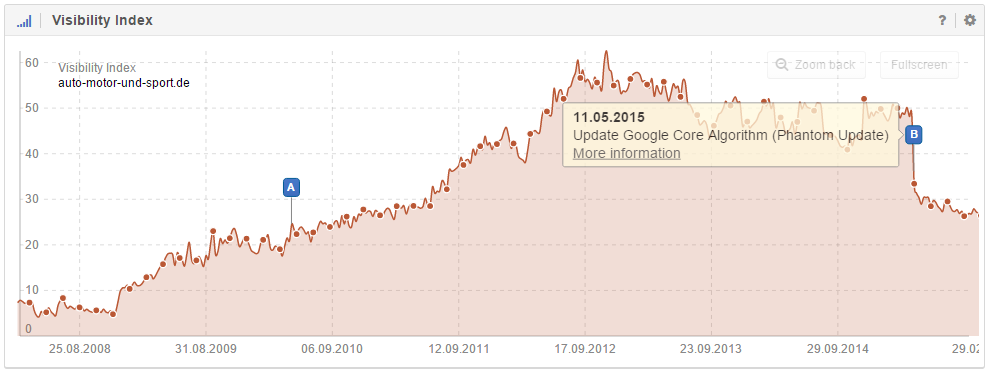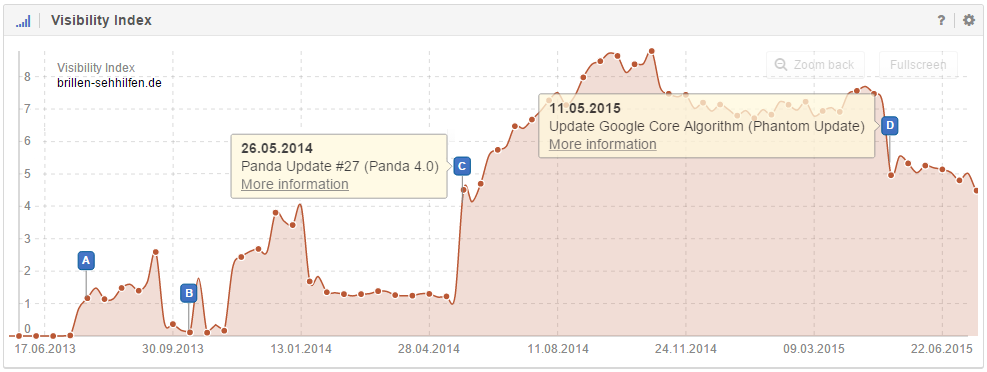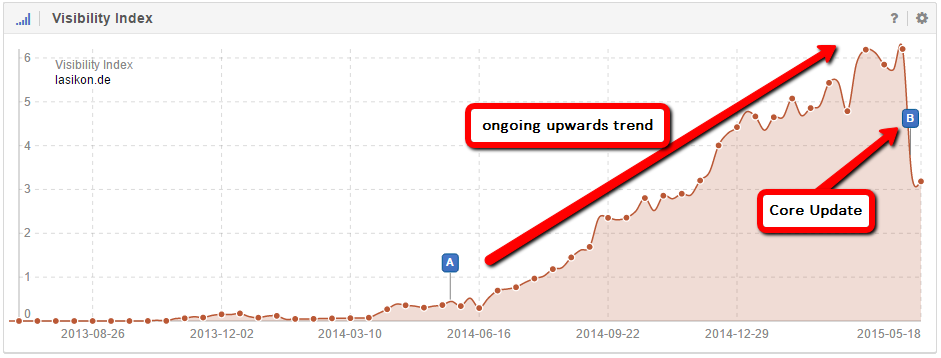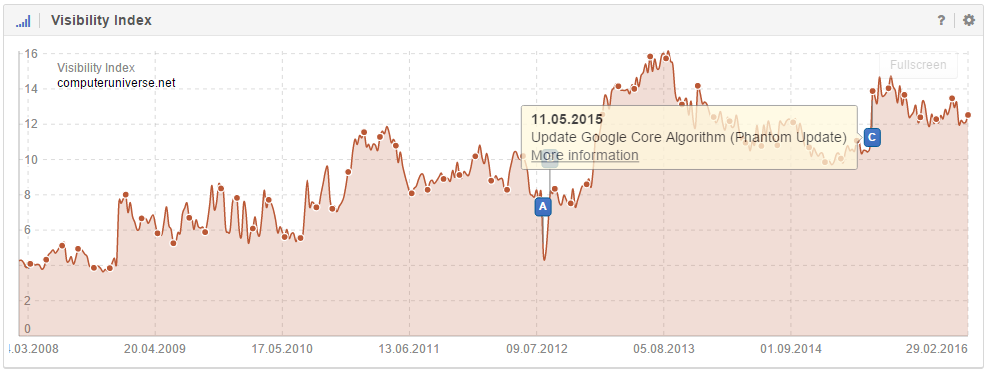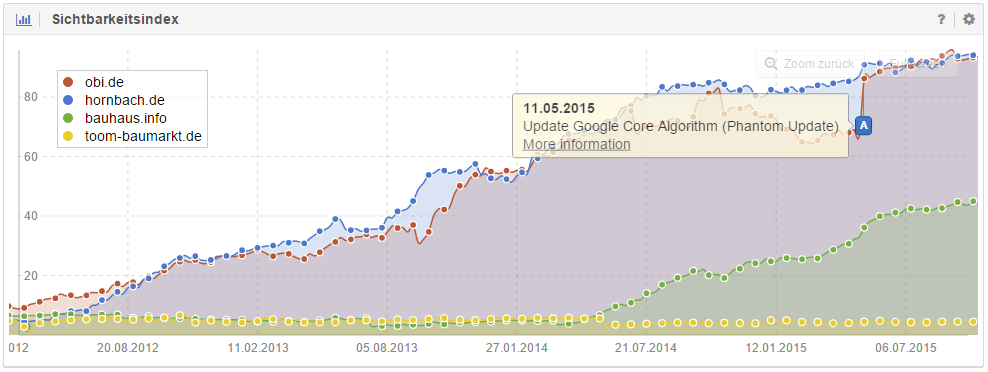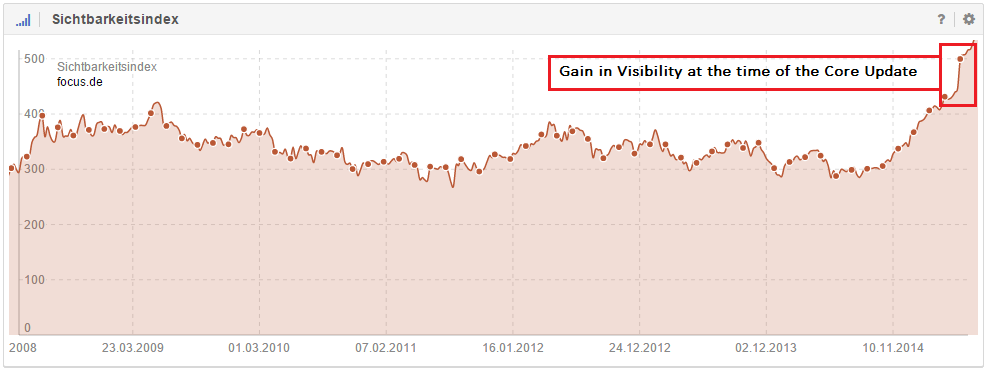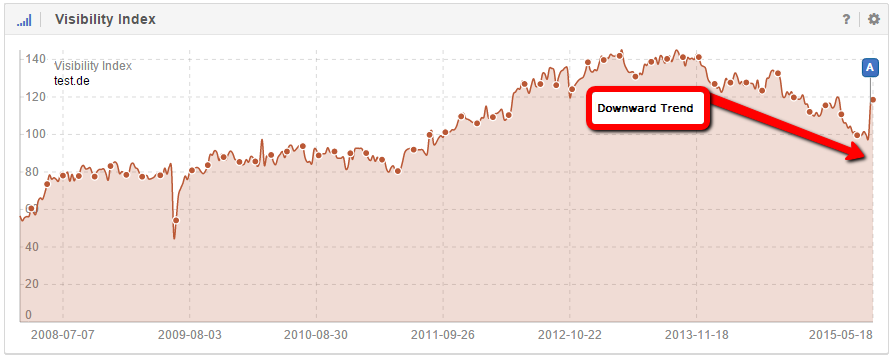Google deployed a core algorithm update at the start of May, 2015. Google chose not to reveal which ranking factors were changed, which is why this update was being called the Phantom Update.
- Google Update without a name aka Phantom Update
- The impact of Google's Core Algorithm Update
- Losing example: editorial portals
- Losing example: high-quality advisory pages
- Losing example: domain with an upward trend
- Winning example: category- and consulting-directories
- Winning example: hardware-store "OBI" compared to the competition
- Winning example: big (brand-) domains
- Winning example: domain with a downward trend
- Free Google Update Check
- How does Google define the quality of websites?
- So what are the factors that Google takes into consideration when rating the overall quality of a website?
- Video: How Does Google Rate Algorithmic Changes?
During the week from 05/04/2015 into 05/11/2015, many domains worldwide saw surprising losses of between 20% to 60% of their Visibility. Google confirmed a change to the core algorithm, the heart of all ranking algorithms. How much has changed or which factor now weighs differently, however, remains unknown.
We have changed the core algorithm a lot with things that are secret and that we won’t communicate. This has nothing to do with the mobile update though.
According to Jonas Weber, from Gary Illyes (Google Webmaster Trends Analyst) panel at the SMX Sydney 2015
Google Update without a name aka Phantom Update
Google says that they deploy about two algorithm changes per day. Those are usually small adjustments, which do not affecting the public at all. Due to this, there were about 665 changes made to the ranking algorithm in 2012. For bigger algorithm changes, Google generally tries to inform the webmasters about which factors concerning the rankings have changed. That can be seen, for example, for the first Panda Update in 2011 or the Penguin Update in 2012.
At the beginning of May 2015, an update went live that was neither announced nor transparently communicated – a Phantom Update, so to speak. According to Google, these were changes to the core of their ranking algorithm. What exactly changed, as well as the how and why, are unknown and remain a company secret, just as much as the question which of the 200 ranking factors is now weighted differently.
At the trade conference SMX Sydney 2015, Webmaster Trends Analyst Gary Illyes from Google confirmed the update to their core algorithm and made it clear that this had nothing to do with the Mobile-Friendly ranking factor update that happened on the April 21, 2015. He also ruled out the possibility of a data-refresh for the Panda- or Penguin-Filter, as the cause.
The impact of Google’s Core Algorithm Update
Google’s Core Algorithm Update influenced website operators worldwide and the impact on the search rankings were very significant, in some case. Big webpages, as well as mid-sized or smaller ones won or lost Visibility seemingly at random. A first analysis of the data did not show any of the common indicators of which factor could have been weighted differently. We now want to show you a small selection of domains where there is a high probability of the Visibility change being due to the Phantom Update.
Losing example: editorial portals
Editorially run portals, like, for example, the German auto-motor-und-sport.de – a journal on cars – lost more than 30% of their SISTRIX Visibility index value. The cause for this is, apparently, not limited to a single directory, which means the Google Core Algorithm Update may evaluate the whole domain anew.
Losing example: high-quality advisory pages
Even advisory pages with high quality content, be it of textual or graphical nature, lost 30% of their Visibility after the Core Algorithm Update. Here is a practical example in case of the domain brillen-sehhilfen.de – a German domain for eyewear:
Martin Mißfeldt, who owns this domain, tried to identify the cause and effect of Google’s Core Algorithm Update on his projects in a blogpost (in German). According to Martin, the traffic and earnings decreased noticeably on the day the update was deployed.
Losing example: domain with an upward trend
Even domains that had a solid upward trend in the SISTRIX Visibility index could be negatively impacted by this “unknown” update. Here is an example for the domain lasikon.de – a German domain on laser eye-surgery:
Winning example: category- and consulting-directories
Computeruniverse.net, an online shop for computer electronics, gained more than 25% Visibility when the Google Phantom Update went live.
If we look at the differences on a directory level for the domain, we notice that both the “purchase advice” and /groups/ directories gained Visibility. This means that, in this case, there seems to have been a targeted re-evaluation on specific parts of the domain.
Winning example: hardware-store “OBI” compared to the competition
After the Core Algorithm Update, the German hardware-store OBI gained almost 30% of Visibility and therefore profited a lot from the update. If you compare the domain to other competitors in the hardware-store segment, you can easily see the growth:
Winning example: big (brand-) domains
Looking at our sample, it became quite noticeable that a lot of big (brand-) domains gained Visibility when the Core Algorithm Update was deployed. Examples are focus.de, brigitte.de, check24.de and more – all of which are well known brands in Germany.
Eren Kozik noticed the same during his own analysis of Google’s Phantom Update and suspected that strong brand-domains see a kind of preferred treatment. Such a comprehensive change last happened in 2009 with Google’s Vince Update (aka Brand Update).
Winning example: domain with a downward trend
The website for “Stiftung Warentest” – a German version of the American “Consumer Report” – which is available at the domain test.de, was in a so called downward trend in the SISTRIX Visibility index since December 2013. This means that the domain’s ranking positions got worse week over week. Thanks to the Google Core Algorithm Update, the domain seems to have gotten back 20% of its Visibility and the downward trend seems to have stopped.
Free Google Update Check
Is your domain affected by the Google Core Algorithm Update? Find out quickly and easily. We have collected all relevant algorithm changes in our Google Update-Checker. Just type in any domain and get the results, for free.
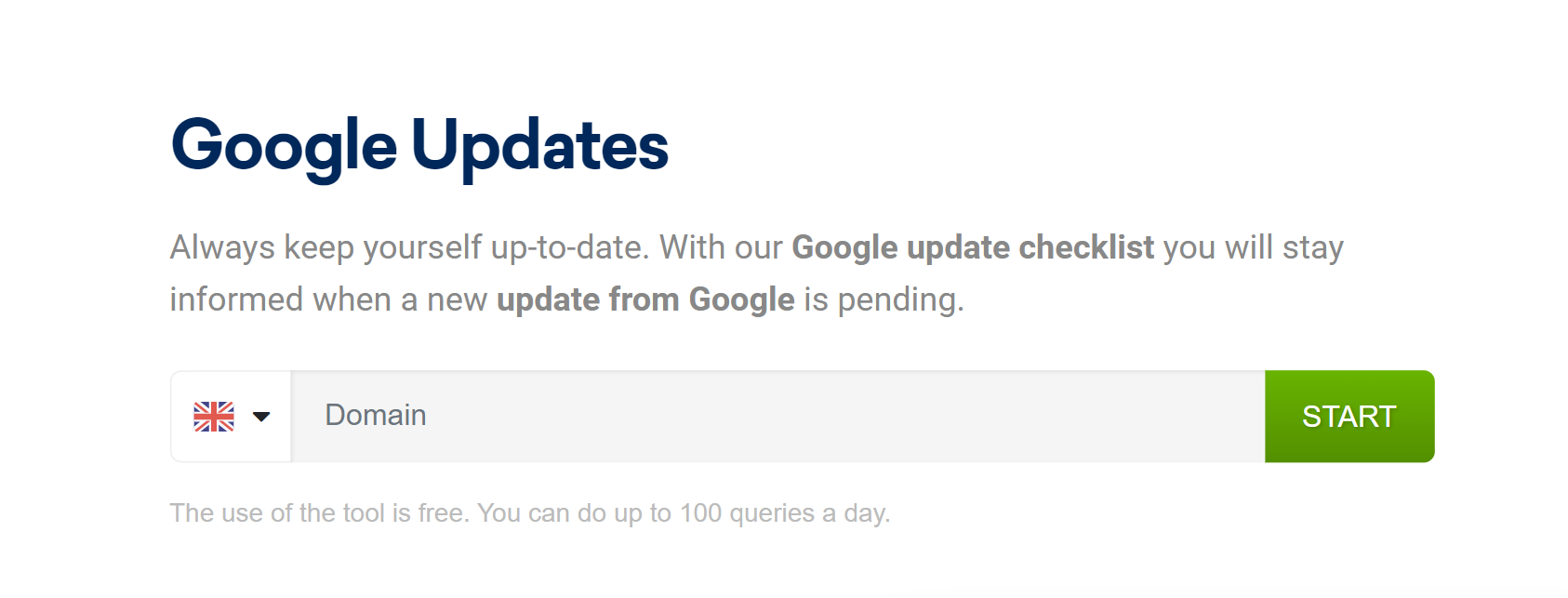
How does Google define the quality of websites?
With the Phantom Update, Google changed the way the ranking algorithm decides on the quality of a website. To be specific, some parameters in the core of the algorithm were adjusted which are in charge of how the quality signals from a website are processed.
[…] there were changes to its core ranking algorithm in terms of how it processes quality signals. – Google’s answer to an article on Search Engine Land– Google’s answer to an article on Search Engine Land
Even John Mueller, Google Webmaster Trends Analyst from Switzerland, talked about the update in one of his German “Webmaster Central Office Hour“-hangouts, where he explained that it was more like a regular adjustment, with the goal of presenting the users with even higher quality websites in the search results.
According to John, Google is trying to algorithmically rate the entire quality of a website. The quality of the content, which is secured largely by the Panda Filter, is only one factor. The Google-Bot looks at much more than just if a website can be displayed correctly. They will, for example, also try to determine the user experience for the website.
So what are the factors that Google takes into consideration when rating the overall quality of a website?
John says that the Core Algorithm Update did not add any really new quality factors that are checked out. Instead, webmasters should look at the 23 questions about your own website in an honest and critical way. Looking at a website with these questions in mind is not new for Google. Back in 2011, Amit Singhal, Google fellow and software engineer, already mentioned the most important of these questions.

